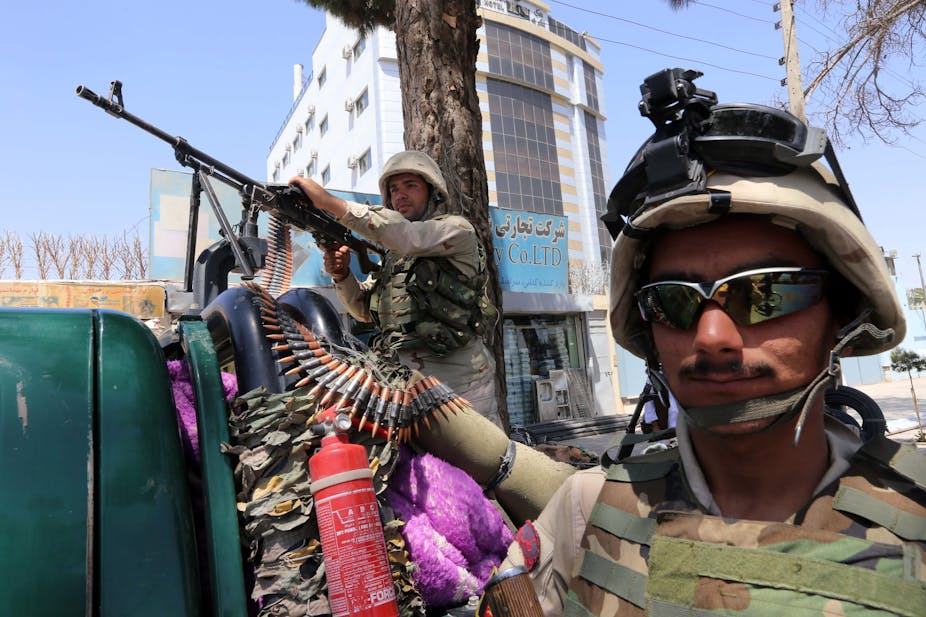The US major-general killed in an insider attack at a military academy near Kabul is the highest-ranked US casualty since 9/11 and the wars in Iraq and Afghanistan. Another 15 officers were wounded, including a German brigadier-general, in the attack during a high-level meeting at a new defence academy that was [modelled on the Royal Military Academy at Sandhurst](http://www.bbc.co.uk/news/uk-24629331](http://www.bbc.co.uk/news/uk-24629331).
Major-General Harold Greene was a widely admired communications specialist who was in Afghanistan to oversee the handover from US to Afghan forces, a key role that made him a particular target for armed opposition groups. The incident brings into focus the more general state of security in Afghanistan at a time when numerous sources are reporting an upsurge in Taliban capabilities, and just as the great majority of coalition forces are concluding their deployments.
Just last week, President Hamid Karzai’s powerful cousin, Hashmat Karzai, was killed at an Eid al-Fitr celebration at his home in Kandahar Province after a well-dressed guest came up to him and detonated a suicide vest. Hashmat Karzai was close to one of the two presidential candidates, Ashraf Ghani – and the long drawn-out failure to complete that election has added to the air of uncertainty affecting the country.
Security problems have developed in many areas. One example has been extensive difficulties with the logistic support for the 7,000-strong rapid reaction force, a key new element in the Afghan Army’s forces. This is heavily dependent on 350 mobile strike-force vehicles made by the US arms company Textron, but spares and other support for the force have simply not been made available, mainly because coalition forces have not been able to ensure sufficient security for Textron to supply the stores.

Yet another problem is that as many as 200,000 weapons supplied to the Afghan National Army (ANA) are not accounted for. Given the worries over Taliban infiltration of the ANA, not forgetting yesterday’s attack, the impact of this could be considerable, stretching over some years.
Taliban rising
By the end of this year, most of the coalition forces will have left the country. Even now, very few patrols are being conducted and the great majority of coalition troops are engaged in the complicated withdrawal process in which efforts are being made to remove or destroy the billions of dollars of equipment brought into the country over the past 13 years.
The United States hopes to maintain a force of around 10,000 troops in the country compared with its peak deployment of 100,000 three years ago. Both the presidential candidates in Afghanistan support this, but the upsurge in Taliban activity is causing considerable concern. They and other armed opposition groups are making gains across the country, extending their reach beyond their previous main areas of control in the south and south-east, and are threatening supply lines close to the capital, Kabul.
These groups are also responsible for an upsurge in casualties among the Afghan army and police force which was established last year but by the end of the year was running at around a hundred killed every month. In recent months the defence and interior ministries have actually stopped publishing the casualty figures for the security forces, but UN statistics show a 24% rise in civilian casualties in the first six months of this year compared to the same period a year ago.
A further indication of the problem is that civilian casualties are more likely to stem from direct fighting between Taliban and government forces rather than roadside bombs, which shows the way in which the Taliban are now fighting more openly. This presents a change in their approach because frontal attacks on western troops in the past were just too costly.
US withdrawal on hold?
One other aspect of the changing environment is important. The Taliban may have increased their levels of action against Afghan forces, but they are unlikely to push this too far during the summer months – what is euphemistically called the “fighting season”. If they do, then the United States might decide to keep larger forces in the country in order to support the Afghan government beyond the end of this year.
The current intention is to keep those 10,000 or so troops in Afghanistan, partly to handle training missions but also to support the use of drones and maintain Special Forces for searching out groups that might link to al-Qaida elements in Afghanistan and north-west Pakistan. If the Taliban get so strong that they are threatening the very survival of the Kabul government, then the Pentagon will argue for keeping far more troops in the country.
From the Taliban perspective it is better to demonstrate some of their power without making this excessive. They can then bide their time over the next year, work out just how powerful US forces still are in the country, and then undermine the government slowly while consolidating their control of substantial parts of the country.
The war in Afghanistan is largely forgotten in the West with all the attention on Gaza, Iraq, Syria, Libya, Nigeria and elsewhere, but it is far from over. And judging by the killing of General Greene, US involvement in Afghanistan will stretch over many years to come.

